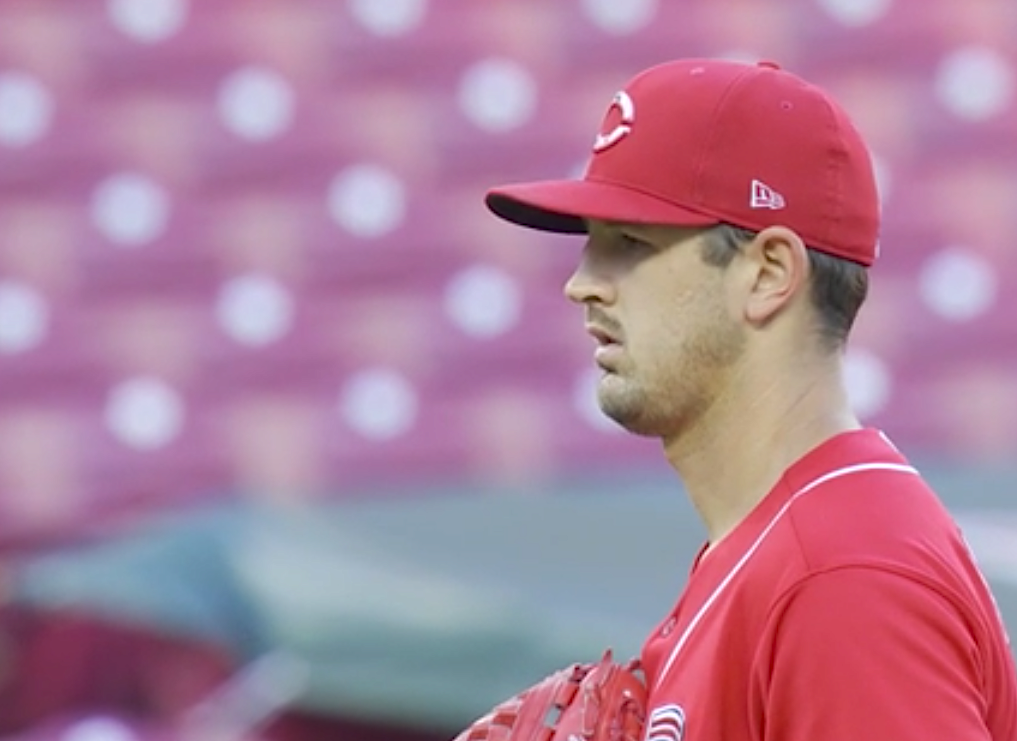
Tyler Mahle has been an invaluable member of the Reds’ rotation in 2020, stepping in to fill voids left by injuries and ineffectiveness. In fact, he’s pitched well enough to bump Anthony DeSclafani and Wade Miley from the rotation.
In 45.1 innings, Mahle has a 3.57 ERA, 3.96 FIP, 4.53 xFIP, and 4.02 SIERA. Outside of his xFIP, those are all career bests. Behind those improved metrics is an improved strikeout rate. Mahle has moved from above average (23.2%) to elite territory (29.6%) in K%, and he’s also set a career high — by far — in whiff rate (33.8%). His previous career high in whiff rate was 24.2% in 2018.
We’ve written about the development of Mahle’s slider multiple times this season. It’s a huge piece of Mahle’s success and why he’s missing more bats.
But we can’t overlook the improvements Mahle has made with his four-seam fastball.
The heater was always dubbed Mahle’s best pitch as he came up through the Reds’ system. Touted for his command it and ability to ratchet its velocity up to 99 mph when he needed to, Mahle essentially rode the fastball all the way to the major leagues. While it flashed potential in his first two years with the Reds, it wasn’t as consistent as he needed it to be considering that he throws it more than half the time. But in 2020, it’s starting to come together for Mahle:

The most notable improvements come in the batting average, expected batting average, and whiff rate. Normally, after only 45 innings, we might dismiss this as random variance due to a small sample size. However, Mahle is doing something different with his fastball this year that is very likely to explain the improvements.
You probably guessed it: like many other Reds pitchers under the tutelage of Derek Johnson and Caleb Cotham, he’s increased his spin rate — and considerably so.
Mahle averaged 2,161 rpm on his fastball in 2019, which was only in the 33rd percentile among all pitchers. This year, he’s bumped that average up to 2,391 rpm, placing him in the 74th percentile. As we’ve written about here at RC+ many times, higher fastball spin equates to more whiffs and pop ups.
“Professional hitters have seen thousands of fastballs in their careers. They’ve come to expect a certain amount of drop. As a result, they’re more likely to swing under a high-spin fastball, particularly if it’s up in the strike zone. If they make contact, they’re more likely to pop it up. This is why a low-spin fastball can be effective, too — it drops more than average and results in more ground balls. An average spin rate gets pitchers into trouble with their four-seam fastball because it doesn’t rise or drop enough to fool hitters.”
But he’s done even more than add 200 rpm to his fastball. He’s dramatically increased its spin efficiency, or active spin. What does this mean, exactly? I’ll let the folks at Baseball Savant explain this one:
“When thrown with pure top or backspin, then 100% of the spin contributes to movement. You can also throw a pitch with some side-action so that some of the deflection will go up or down, and some will go side to side. All of this is Active Spin.
For a football, none of the spin contributes to movement, and so, a football has 100% Inactive Spin. In order for a baseball to have Inactive Spin, you would twist your arm slightly so that the baseball is thrown more like a football. The more the baseball is thrown like a football, the more the spin of a baseball will go from Active Spin to Inactive Spin.”
To put it simply: a fastball with a high spin efficiency is going to drop even less and cause more hitters to swing underneath it. After moving to Houston, Justin Verlander became something of a poster boy for spin efficiency. In 2019, he led all pitchers with a 98.5% efficiency.
Last year, Mahle’s spin efficiency was 87.5%. Not bad, but it ranked 196th among all pitchers. He hasn’t just improved a little bit in 2020 — he’s getting almost perfect spin efficiency on his fastball. Mahle sits at 99.9%, second only to the Diamondbacks’ Stefon Crichton.
Mahle has gone from -1.3 inches of rise (vertical movement) below average in 2019 to 1.7 inches above average in 2020. He’s continuing to get good run (horizontal movement) on the fastball, too, at 4.8 inches above average.
This has played a key role in Mahle’s increased whiff and strikeout rates. It’s also a huge reason he’s lowered his BA and xBA against, too. Among pitchers with at least 40 innings under their belts, Mahle is 14th in infield fly ball rate (14.8%). A significant portion of the credit is owed to his fastball. He has a 15.7% pop-up rate on the four-seamer, more than doubling his rate from 2019 (7.0%) and ranking seventh among pitchers who’ve had at least 50 fastballs put into play this season.
Mahle is in his third full big-league season, so it’s easy to forget he’s still just 25 years old. With significant improvements to his pitch arsenal, he’s finally starting to show the potential the Reds saw when they called him up back in 2017. An afterthought for some people coming into 2020, Mahle has unquestionably earned his spot in the rotation in 2021.


